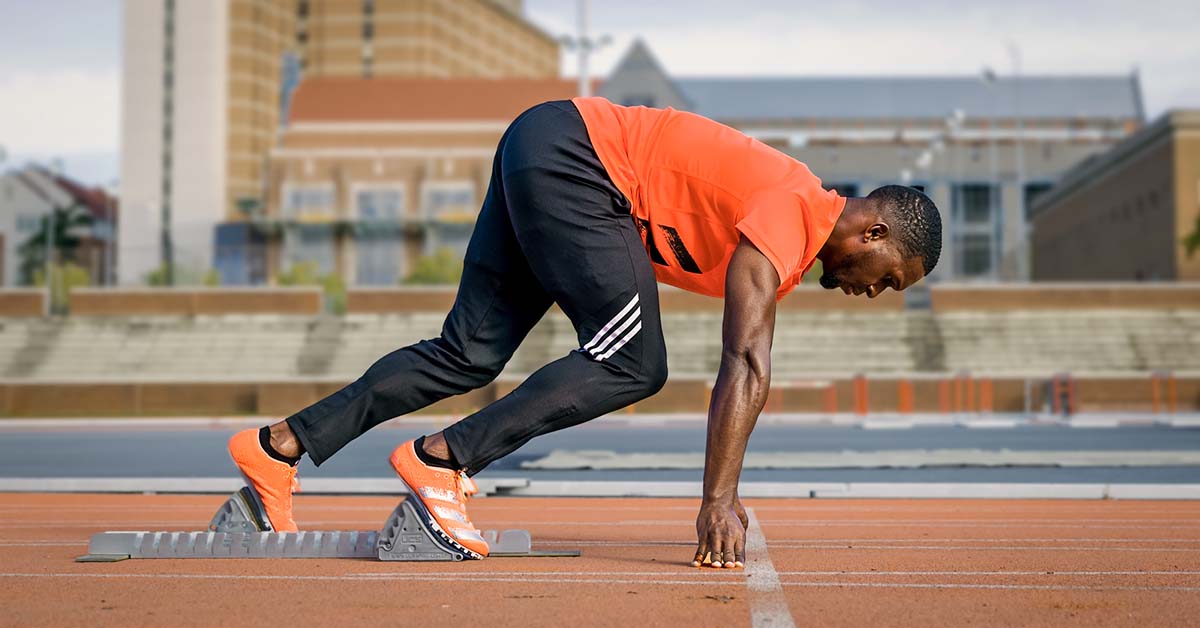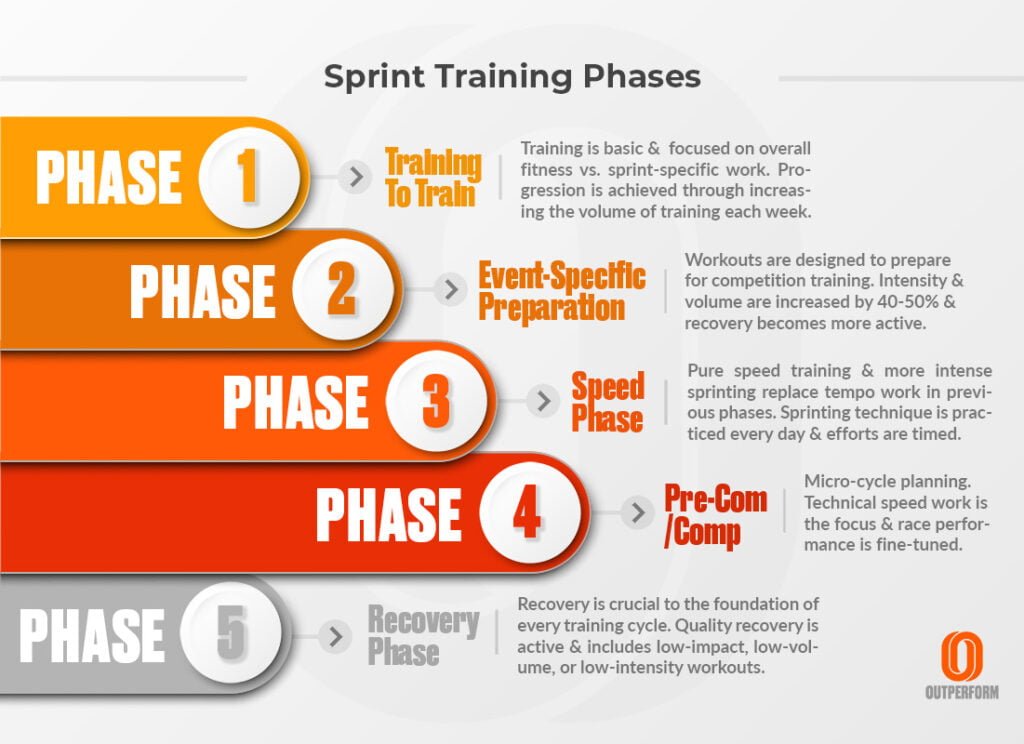
Sprinting is about more than just raw speed; it's the synthesis of form, power, and endurance.
Similarly, building an effective sprint training program requires more than simply completing drills and refining sprinting technique.
It takes specific training with the right timing, intensity, and focus to achieve top-end speed.
Olympian and veteran sprints coach Ken Harnden has developed and perfected sprint training plans that have consistently gotten athletes cross the finish line faster.
In this guide, you'll discover how to create your own sprint training program using the proven philosophies and sprinting workouts Coach Harnden has crafted for his 100m & 200m sprinters.


Why Not Just Use A Sprint Training Program PDF?
Despite what many websites claim, there’s no one-size-fits-all plan for speed development.
The most crucial concept in creating an effective sprint training program is individualization.
Sure, you can easily search for a sprint training program PDF and find hundreds of free and paid options.
But if you’re going to trust your performance to any plan (including ours), it’s worth asking a few key questions.
Who wrote the plan?
Is it from someone who has only "studied the best coaches," or is it crafted by someone with years of experience delivering real results on the track?
The most successful sprinting coaches have spent years working with a variety of athletes, each with unique strengths and weaknesses.
That kind of first-hand experience is what builds the knowledge needed to unlock a sprinter’s full potential.
Who was the plan written for?
A first-year high school sprinter has vastly different needs from an elite college athlete. You need a program that reflects where you are in your career and accounts for your individual strengths and areas for improvement.

Do I have the knowledge to adjust the plan?
This is the most important question to ask.
No matter how well-designed a sprint training program is, you'll need to make adjustments along the way.
As the military strategist Helmuth von Moltke famously said, "No battle plan survives contact with the enemy."
In this case, the ‘enemy’ could be anything—from a virus that takes you out of training for a few days to a hamstring strain that sidelines you for weeks. It might be something as simple as a small change in your track meet schedule.
Even if you remain perfectly healthy, understanding the 'why' behind each part of the plan is crucial for optimal training.
Some athletes thrive with high-volume sprint training, while others need a focus on injury prevention and recovery.
For those in the latter group, it’s essential to know how to prioritize and get the most out of your training.
Whether you’re a coach or a self-coached athlete, balancing multiple factors—such as skill level, training experience, recovery ability, previous injuries, and lifestyle—is key to designing a successful sprint training plan. Plan accordingly.
In the video below, Coach Harnden discusses two sub-10 second sprinters he coached, both of whom needed vastly different training volumes and approaches.
Building a Sprint Training Program
“If you don’t know where you’re going, you’ll end up somewhere else.”
Yogi Berra
Planning is everything. Disorganized, random sprint training will almost always lead to random results.
Great coaches and athletes know exactly what they need to do to perform at their best, and they deliberately work toward it. Every repetition and recovery session is backed by clear, thought-out reasoning.
It’s this calculated planning and purposeful work that drives real progress.
Over his many years of coaching elite athletes, Coach Ken Harnden found that the best way to ensure a successful season is to start by identifying your end goal, then work backward to plan each phase of training.
As you plan your season, start by defining your finishing goal.
- Do you want to improve sprint times by a specific percentage within a set timeframe?
- Do you need to focus on a specific skill, like improving your block starts?
- Is your goal to peak at a particular time or event?
- Is there a meet where you could break your personal record?
Mark your target on the calendar and build your plan in reverse, working back to the very first day.
Watch Coach Harnden discuss the importance of building a plan from the destination in the short video below.
Five Sprint Training Program Phases
Not to be confused with the phases of a sprint race—acceleration, maximum velocity, and deceleration—this is about the phases of training.
The structure is divided into five distinct phases or training blocks, designed to help you build an effective sprint training plan.
Each of these five phases targets specific objectives that will progressively lead you toward your ultimate goal.
Phase One - Training to Train
Before diving into sprint training, you first need to develop a level of fitness that can handle the demands of sprinting.
In this initial phase, the focus is on general fitness rather than sprint-specific work.
Establishing proficiency in foundational sprinting drills for beginners is essential.
Why? Because the movement patterns learned in these drills will carry over to everything else you do on the track.
Progression during this phase comes from gradually increasing the volume of training each week.
The emphasis of Phase One
- Basic training to build general strength and technique.
- No overloading—both intensity and volume should increase slowly.
- The goal is to develop enough fitness to train at a high level without risking injury.
Phase One Sprinting Workout Week
| Day | Workout Type | Workout |
| Monday | Tempo | Warm Up Wickets - 4 x 30M 8 x 250M on grass/walk 50m 3 x Plyos 2 x Med Ball Routine Lung Series Cool Down |
| Tuesday | Low Level Stairs | Warm Up 8 x Stadium Stairs 5 x Half Stadium Stairs (Faster) A/B Skips Sand Walks Ab Work |
| Wednesday | Recovery | Rest |
| Thursday | Tempo | Warm Up Acceleration Complex 8 x 300M Decreasing Recovery |
| Friday | Sand or Plyometrics | Warm Up 3 x Plyo Circuit Lunge Series Cool Down |
| Saturday | Hills | Warm Up 6 x 200M Hills Lunge Series |
| Sunday | Recovery | Rest |
The Most Effective Online Sprinting Course.
Explore CoursePhase Two - Event-Specific Preparation
After building general fitness in Phase One, you’re ready to shift the focus to sprint-specific training. In this phase, both intensity and volume increase, and recovery becomes more active.
Plyometric exercises and hill work ramp up in volume, intensity, and variety. Recovery days now include active, non-impact work, such as pool exercises.
The workouts in this phase are designed to prepare athletes for competition training and should remain consistent throughout the season to measure progress between phases..
This is also the time to introduce more advanced sprinting drills into the warm-up. Examples include "the U Drill" (also known as "the Miami Drill") and the "Advanced 1-2-3 Drill."
These drills target critical sprinting techniques, such as frontside mechanics and proper ground contact.
Emphasis of Phase Two
- The goal is to prepare athletes for event-specific training.
- Increase overall training volume by 40-50% from Phase One.
Phase Two Sprinting Workout Week
| Day | Workout Type | Workout |
| Monday | Speed/Acceleration Tempo | Warm Up 4 x 50M From 120 Start 130/120/110 (Walk Back Recovery) 3 x 150/150 2 x Ab Circuit Lunge Series |
| Tuesday | Power/Resistance Stadium Stairs | Jog Warm Up 8 x Stadium Stairs 4 x 15 Double Hop Stadium Stairs 3 x 10 Single Hop Stadium Stairs 4 x 10 Stadium Stairs Skip Back Sand Drills Ab Circuit |
| Wednesday | Active Recovery | Pool Recovery |
| Thursday | Speed/Acceleration Tempo | Warm Up 4 x 50M From 120 Start 3 x 140M Ins/Outs 4 x 200M 30/90 2 x Med Ball Circuit Lunge Series |
| Friday | Hills | Warm Up Sled Push/Pull Plyometrics Sand Drills Mat Jumps |
| Saturday | Hills | 3 x 250M Hills 3 x 150M Hills 4 x 40M Hills |
| Sunday | Recovery | Rest |

Phase Three - Speed Phase
Phase Three is all about increasing your speed. In this cycle, pure speed training and more intense sprint workouts replace the tempo work from earlier phases.
On the track, traditional speed work becomes the core of the training plan.
Sprinting technique is practiced consistently—from the warm-up through the end of each session. During this phase, efforts should be timed to track progress and set goals to chase.
Emphasis of Phase Three
- Focus on increasing speed.
- Replace tempo work with pure speed development training.
- Begin practicing block starts.
Phase Three Sprinting Workout Week
| Day | Workout Type | Workout |
| Monday | Speed Short Distance | 3 x 20 Falling Starts 3 x 20M 2-Point Starts 3 x 20M 3-Point Starts 6 x Wickets or Sleds Hip & Ab Circuit |
| Tuesday | Speed Longer Distance | 3 x 20M Falling 3 x 20M 2-Point Starts 3 x 20M 3-Point Starts 2 x 250 M Hip & Ab Circuit |
| Wednesday | Active Recovery | Pool Recovery |
| Thursday | Technical Training | 6 x 20M Tape Drill 6 x 20M Block Start 6 x 30M Sleds Hip & Ab Circuit |
| Friday | Plyometrics | 3 x 30M Speed Bounds Plyometrics |
| Saturday | Hills Longer but Lower Intensity | 4 x 60/90/120M Hills |
| Sunday | Recovery | Rest |
Phase Four - Pre-Competition/Competition Phase
Phase Four is dedicated to pre-competition and competition preparation. Training is organized in micro cycles, typically lasting 2-4 weeks, leading up to each competition.
To make meaningful improvements, it’s important to have at least a week between competitions. This allows for the necessary training to continue progressing.
During this phase, race performance is fine-tuned by building on strengths and addressing any weaknesses from previous races.
The focus shifts to technical speed work, with an emphasis on timing, setting timing goals, and making adjustments to hit those goals.
Emphasis of Phase Four
- Pre-competition/competition training
- Ideally, two weeks between competitions for optimal improvement.
- Training should be tailored to each athlete’s needs.
Phase Four Sprinting Workout 2 Weeks
| Day | Workout Type | Workout |
| Monday | Recovery | Recovery Warm Up Core Work Lunge Series |
| Tuesday | Athlete Specific Training | 4 x 40M Wickets 5 x 90M - 8 Min Recovery |
| Wednesday | Athlete Specific Training | 250M/150M/150M - 10 Min Recovery Plyometrics |
| Thursday | Athlete Specific Training | Recovery Warm Up Core Work Lunge Series |
| Friday | Athlete Specific Training | 5 x 20M Block Start 4 x 30M Flying 6 x 30M Sleds Plyometrics |
| Saturday | Athlete Specific Training | 250M/150M/150M - 10 Min Recovery Plyometrics |
| Sunday | Recovery | Rest |
| Monday | Athlete Specific Training | 5 x 20M Block Start 5 x 20M Sleds Plyometrics Hip & Ab Circuit |
| Tuesday | Competition Prep | Recovery Warm Up Core Work Lunge Series |
| Wednesday | Competition Prep | 4 x 30M Wickets 2 x 120M |
| Thursday | Recovery | Rest |
| Friday | Competition Prep | Competition Preparation |
Recovery Phase
Recovery is a critical component of every training cycle and should be intentionally built into each phase of your sprint training plan. At the end of each phase, a dedicated recovery week is essential.
Effective recovery is active, involving low-impact, low-volume, or low-intensity workouts to allow your body to recuperate while staying engaged.
Off the track, recovery extends to your lifestyle. Proper nutrition, hydration, and sleep are vital to ensuring full recovery between training sessions and maintaining peak performance.
Emphasis of Recovery Phase
- Active recovery aligned with the overall training structure.
- Hydration, nutrition, and sleep are essential.
Recovery Workout Week
| Day | Workout Type | Workout |
| Monday | Sand/Turf Recovery | 2 x 10M Falling Start 3 x 10M 2-Point Start 3 x 120/90/60M |
| Tuesday | Lower Intensity | 6 x 20M 3-Point Start 6 x 20M Sleds Plyometrics |
| Wednesday | Recovery | Pool Recovery |
| Thursday | Sand/Turf Recovery | 8 x 40M Block Starts 6 x 20M Sleds |
| Friday | Pool Recovery | Pool Recovery |
| Saturday | Hills Low Intensity | 3 x 150/120/90M Hills |
| Sunday | Recovery | Rest |
Conclusion
We hope you found this sprint training program guide helpful.
The basic structure outlined here has consistently delivered significant results when customized to meet individual needs.
If you’re curious about everything sprinting does for your body—from building muscle to boosting testosterone and making you smarter—don’t miss our latest article on the benefits of sprint training.
For more insights on developing and refining a year-round training plan, be sure to check out Sprinting Smarter, Speed Progression.








Great article! Love the emphasis on individualization and the 'why' behind each part of the sprint training plan. As a coach, I will definitely be incorporating these concepts into my own training programs.
Curious what are you recommending for warm up, a skips b skips etc? How long. Thank you for sharing your insights and experience!
Thanks Mark! We actually have a guide on sprinting warm-ups that will be posted soon.
Yes, a and b skips focusing on ground contact and mechanics, straight leg bounds, dynamic stretches (leg swings, shoe sweeps), glute activation drills etc.
In terms of how long, if you are talking about distance 20 meters. Check back in a week and you'll see it all broken down.
I need the program more like what to do as 100m what to do for 200m what to do for block starts
I hope u guys understand..
Just make it clear cos there is some of us that's do not have like stairs advantage..
100m and 200m are very similar training and should be the same for block starts. If you want a detailed guide check out https://outperformsports.com/block-starts-for-track/ and let us know if you have any questions.
How long each phase should last , phase 1 & 2 I’m more concern please
It really depends on the athlete, how old they are, their response to training etc. For example, a high school sprinter that plays another sport in the fall might not start their phase 1 until Jan so it would be a bit shorter. College level sprinters might have anywhere from 8-16 weeks of phase 1 and 4-8 weeks of phase 2.
In general, phase 1 is anywhere from 4 to 12 weeks and pre-competition or phase 2 is 4 to 8 weeks.
I am 30 year old with some not much but some training experience . What could be ideal for me like 8 week each fase ?
If you don't have a lot of training experience you'll want to spend a good amount of time in the general preparation phase to prepare your body and reduce the risk of injury. So at least 8 weeks and slowly build in intensity and volume. Listen to your body and keep a training journal. That will really help to inform you of when to move on to the next phase.
I’ll be honest I jump from nothing to phase 4 lol been doing it for 8 weeks and I went from 12.30 to 11.40 . I feel great so should I start from phase one after I compete in the master next month ?
That's some impressive gains in a short time! It's difficult to say, there are a lot of factors. Typically after the competition phase you would take some time off and do some other activities for a month or so. So yes, after the season going to phase 1 is a good idea. The stronger base you build the better your performance will be.
Please give me 100m off season workout plan
my competition coming soon i think i have 2 month plzz suggest bi best plan for my competiton i run 100m in 11.20sec 0r 200m in 24.04 sec i am 23 year old university student from pakistan i have no coach my coach is internet i dont afford coach i start training again after 1 month rest plzz sir suggest me best i hope sir u help me
Training plan for 100 and 200 m races???
Yes, this training plan structure would apply to both the 100m and 200m.
How to improve 400m
Hi Keshav,
Improving your 400m time is a holistic process that blends various training components. Starting with speed work, incorporating short sprints ranging from 60m to 150m can help you build explosive power and improve fast-twitch muscle responsiveness. Mixing these with interval training sessions, where you might run 200m and 300m at near race pace, take a brief rest, and then repeat, can elevate your lactate threshold—a crucial factor in the 400m.
Strength is another vital component. Plyometric exercises such as box jumps can enhance power and explosiveness. Complementing plyometrics with weight training—focusing on compound movements like squats and deadlifts—can bring significant gains. Don't forget the importance of a strong core, crucial for sprinting mechanics.
Speaking of mechanics, refining your sprinting technique can lead to more efficient energy expenditure. Improving elements like arm swing, posture, and foot strike not only conserves energy but also reduces the risk of injuries.
Recovery, often overlooked, is paramount.The 400m is as taxing on the mind as it is on the body, so mentally prepping can make a world of difference.
Best of luck with your training!
I just started coaching youth track and field last year due to the fact that my daughters track coach moved out of town. How long would you recommend phase 1 for 8-12 year olds?
Hello Vincent, Congratulations on stepping up to coach youth track and field!
When it comes to phase 1 for sprint training for 8-12 year-olds, the primary focus should be on foundational skills, technique, and enjoyment.
For this age group, phase 1 could last anywhere from 4-8 weeks (sometimes longer). This allows ample time to establish proper technique, posture, and basic running mechanics. However, the exact duration can be adjusted based on how quickly the athletes grasp the fundamentals.
Establishing a training structure and proper technique early on is important but it shouldn't be the primary focus at this developmental stage, it's also about building confidence and ensuring that each session leaves them wanting to come back for more. Introducing them to the basics of sprinting through a combination of structured drills and playful activities can strike a balance between learning and having fun.
Best of luck with your coaching journey!
Thank you so much for making this guide! I'm creating a spreadsheet to track and log my workouts. I have a quick question about how the workouts of each phase are structured. In Phase 1 on Monday, for example, you write:
"Warm Up Wickets - 4 x 30M 8 x 250M on grass/walk 50m 3 x Plyos 2 x Med Ball Routine Lung Series Cool Down"
Would the workout for this day be as follows?
- Warm Up Wickets (4 x 30 m)
- Warm Up Sprint (8 x 250 m)
- Walk (50 ms)
- 3 Plyometric exercises
- 2 Medicine Ball Lunge exercises
- Cool Down
I'm also transitioning from endurance running to sprinting. I tried doing it on my own and ended up tweaking my back. Do you have any advice on how I can incorporate my back recovery into this training plan / transition from running half-marathons to sprinting?
Appreciate any guidance you can offer!
Hey Chad, so the warm-up would be your warm-up routine. Followed by wickets, then the 250m on grass etc.
Sorry to hear about your back injury. Transitioning from endurance to sprinting requires adjusting to different mechanics and muscle activations. First and foremost, consult a physical therapist or sports medicine specialist for personalized advice on your injury. Strengthening your core and working on range of motion drills will help, so consider exercises like planks and stretches for hip flexors, hamstrings, and glutes. Ease into sprinting, start adding short accelerations to your easy runs to introduce your body to faster speeds without the full brunt of sprinting. Emphasize proper sprinting technique; hiring a sprint coach or taking our "Sprinting Smarter, Speed Progression" course can be invaluable here. And remember, your body has been conditioned for endurance running, so be patient as it adjusts to new demands.
Thank you so much for this write-up, please I want to what time of the year (month) each phase covers. Please the phases runs from what month of the year to what month. Thanks
I'm glad you found the write-up helpful! The timing for each phase typically aligns with the athletic season, but it can be adjusted based on specific needs and the region's competition calendar. A general breakdown might look like this:
Preparation Phase: Early September to mid-October.
Event-Specific: Mid-October to December.
Speed Phase: December - January/Feb
Pre Comp/Competition Phase: February to late May.
Recovery Phase: June to August.
However, please note that this is just a general guideline. Depending on the athlete's goals, competition schedule, and specific circumstances, adjustments can be made.
Very good
Work
Would this affect other components such as tackling or when receiving a ball at high speeds? otherwise it's a very good article and am excited to try it out!
I am a 16 year old Indian with a timing of 11.30. I am not able to understand this. How can I get better, what should I do in off season ,does I need to work of strength or how can I increase my speed. how should I plan an year to get better. I'LL send you all my timings and detail, so you could help me. Please sir, I'll remember you forever and thankful to you.
Thankyou sir